How can you tell if you have diabetes? Well, in most of the cases it depends on the type of diabetes because especially the signs of type 2 diabetes can be so mild that you probably do not even realize them. In this article, you will learn about the early signs of type 1 and type 2 diabetes.
In the age of self-awareness and mindful thinking, it’s become common practice to take stock of our personal well-being. We have social media guru’s touting the latest diet trends or vitamin score. There are health journals to track hydration, exercise, and food diaries.
We even have apps to remind us of our need for meditative moments to balance the stress of our day-to-day lives. So how is it possible that people can be so critically unaware of what is happening in their own bodies that they could endure blood glucose levels upwards of 200% higher than normal, with early signs of diabetes abounding, and NOT know it?
Well, the answer to that is simple. A great many of the symptoms of diabetes can often masquerade as less dangerous dancing partners which can create one tricky tango.

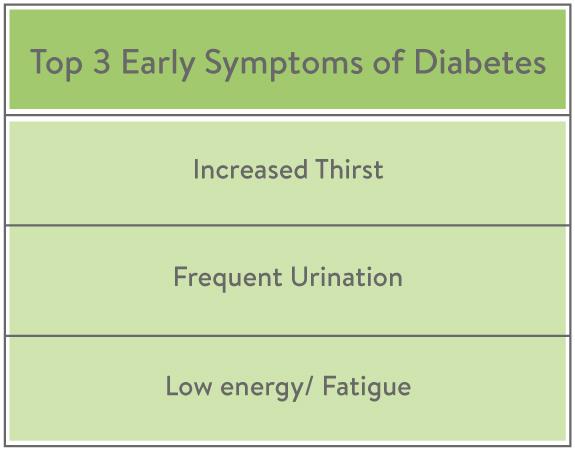
The three most common early signs for both Type 1 diabetes and Type 2 diabetes are increased thirst, frequent urination, low energy and fatigue.
The body attempts to flush the extra glucose out of the system via the kidneys and with the glucose goes additional fluids and critical nutrients your body would otherwise use. Quickly getting control of your elevated blood glucose levels can make for a positive long-term outlook!
Diabetes symptoms are often similar to flu or virus
Unfortunately, as important as these symptoms are at pointing to a critical lack of bio-available Insulin, they are also common symptoms for nearly every cold, flu, and virus known to man. It is easy to see how a busy person might write-off a bit of nausea if they’ve recently been feverish and ill.
However, if illness symptoms have subsided, and that lingering thirst is still nagging, a trip to the doctor should be in order. A simple fingerstick can be wildly illuminating! The combination of increased thirst, frequent urination, and unexplained weight loss are key early signs of diabetes and can point to a critical rise in blood glucose levels.
These 3 early warning signs of diabetes are merely the common denominator between Type 1 and Type 2. Individually, they each have unique early symptoms.
Before we dive down the rabbit hole on early warning signs of diabetes there is an essential bit of information to understand. Defining the various types of diabetes (and there are more than 2, to be clear) would be an entire lexicon of posts on its own, but fear not. For the sake of brevity, we can share in the simplest of terms that both Type 1 and Type 2 diabetes stem from the same biological cause: the body lacks access to Insulin.
Your entire body runs on glucose to fuel everything from brain function to fingernail growth. The cells receive that glucose via the vehicle Insulin. Thus without Insulin (a hormone usually made by the pancreas), the entire body begins to lose energy it needs to function properly. People with type 1 diabetes have a pancreas that is unable to produce Insulin due to an auto-immune attack. People with type 2 diabetes still make Insulin, but their cells struggle to utilize that Insulin. This variation is the critical difference in how the early symptoms for diabetes begins to vary between the two types.
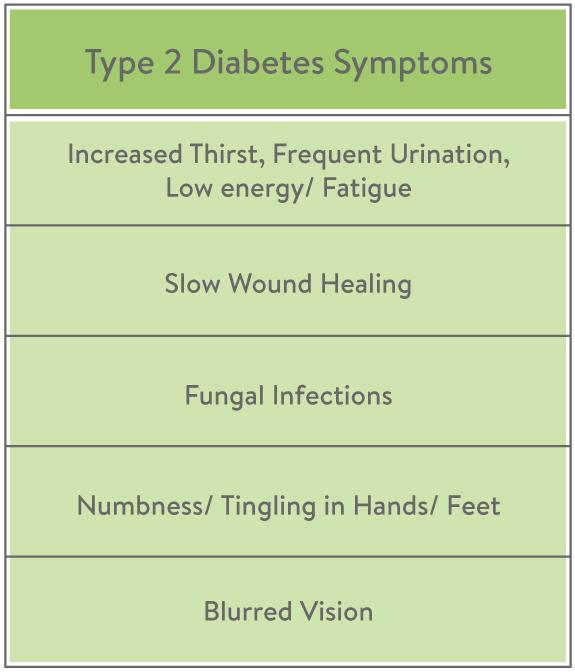
What Are The Early Symptoms For Type 2 Diabetes?
In Type 2 diabetes, the progression from fully healthy to fully diabetic can be a slow progression over a period of years. The body continues to make Insulin, but the cells slowly lose the ability to access it, and the glucose levels begin to climb and the body starts producing more insulin to compensate the high blood sugar levels. The change might not be immediately noticeable since there is zero pain associated with this process. But the warning signs of long-term elevated blood glucose begin to manifest all throughout the body.
Your eyes struggle as the glucose wears on the blood vessels causing blurred vision. With early intervention this can be treated, but left untreated for too long and a condition called Diabetic Retinopathy can occur and cause permanent long-term damage to the blood vessels of the eyes.
Hands and feet can experience numbness and tingling from peripheral neuropathy. The excess glucose creates a breeding ground for advantageous fungal infections systemically on your skin, nails, and genitals. This yeasty beasty can cause even the smallest wound to take forever to heal… if it heals at all.
Early intervention and correction for elevated blood glucose can promote proper circulation and healing. If left unchecked too long, wounds can become infected and cause more problems down the road.
Type 2 diabetes can strike at any age but typically appears as a person ages. Food choices and exercise can both dramatically improve the level of health and glucose control for a person with Type 2 diabetes. Early intervention and treatment can drastically impact both quality of life and long-term health.
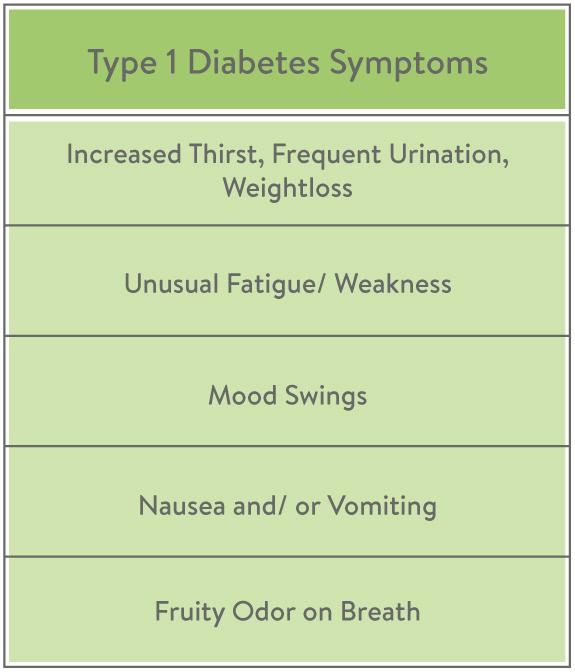
What Are The Early Symptoms For Type 1 Diabetes?
In Type 1 diabetes, the progression is far more dramatic. A silent auto-immune attack begins (researchers don’t fully know why yet), and the pancreas suddenly loses the ability to produce Insulin.
Full stop.
Within a matter of weeks, or sometimes months, a fully healthy individual is deprived of bio-available Insulin. Glucose levels will climb to dangerously high levels, and with it, Ketone bodies will build up.
Ketones (also called serum ketones or beta-hydroxybutyric acid for my geeky medical lovers) are an organic compound the body makes when there is not enough insulin in the blood. In the absence of insulin, the searches for energy from other sources and begins to break down fat for fuel.
Ketones are the byproduct of this process. Ketones in the blood can bring about a general malaise of cranky fatigue and weakness. Early intervention can provide Insulin and begin flushing the ketones out of the body before long-term complication occurs.
High Ketones also make the stomach more acidic leading to nausea and vomiting. In an attempt to rid the body of sugar in any way possible, the body will signal the brain to drink more water to flush the kidneys, and even a person’s breath will smell sweet and fruity. At it’s worst, the ketones can escalate to dangerous levels in the bloodstream and a person can enter Diabetic Ketoacidosis (DKA).
A Note About The Very Young: Infants, toddlers, and young children are unable to efficiently express what their bodies are feeling. This can leave parents of the very young sometimes unable to pinpoint some of the early symptoms of diabetes and even miss completely many of the early symptoms for Type 1 diabetes. Extreme hunger and thirst are fairly easy to see as a sudden spike in snacks and/or bottles will be plainly evident. These are common during regular growth spurts as well are not necessarily a cause for immediate concern. However, parents can monitor for these additional side-effects of elevated blood glucose levels in the infants and toddlers and seek their pediatrician’s immediate guidance if they note the following:
- Uniquely challenging and/or reoccurring diaper rashes due to yeast growth.
- Uncharacteristic mood swing cycles (from weepy to tantrums to hyperactive) due to rapid changes in blood glucose levels.
- Slowed growth (percentages dropping on the charts) despite extra food intake.
- Sleep disturbances at night or during daily naptimes due to low blood sugar episodes and, in toddlers. This can look like a sudden need to feed in the night again outside of the normal growth spurt cycle.
Type 1 diabetes can also strike at any age. The abrupt halt of Insulin production and rapidly elevated glucose levels can turn to DKA very quickly. These early signs are critical, emergent, and always requires urgent medical attention and a lifelong commitment to Insulin injections.

When to See a Doctor About Early Signs of Diabetes
The early symptoms of diabetes can masquerade as a lesser sickness in any number of ways, so it can sometimes feel confusing to know what to do. Fear not! We are here to help guide you! If you are concerned that you, or someone you know, might be showing signs of diabetes, start by asking yourself a simple series of questions.
- Once a cold or flu has run its course, is recovery quick or is there lingering thirst and malaise?
- Have you had your vision checked recently to rule out a need for glasses?
- Do your hands/feet experience numbness and tingling all the time, or is this new?
- Have you always wrestled with the yeasty beasty, or are recurring infections a new struggle?
- How long have you noticed weight loss you can’t explain?
- How long have you or your child been guzzling water without feeling satisfied?
When in doubt, just ask!
Early diagnosis and treatment can make a world of difference
Check-in with your primary health practitioner and discuss your concerns. A simple office visit, and a finger stick or lab draw, can supply them and you both a wealth of information. Early diagnosis and treatment can make a world of difference in stemming the tide of those early symptoms, and your doctor or nurse practitioner will be GLAD to open a dialogue with you.
According to the Worth Health Organization (WHO), about 422 million people worldwide have diabetes. The American Diabetes Association estimated that out of the 34.2 million American adults with clinical diabetes, over 20% of them (that’s just over 7.3 million, to be exact) were unaware and undiagnosed.
With just a little education and awareness, we hope to help lower that to ZERO!
It’s why we work so hard to educate and advocate for the diabetes community…and now our non-diabetes community as well. Our technology team is continually pushing the envelope to simplify life for people with diabetes, and we strive to work hand in hand with the medical professionals to create seamless and accessible coaching for people living with diabetes.
We recognize the staggering costs that the burden of diabetes places on the workforce, and we aim to create wellness programs to partner with employers and help reduce that overhead. We hope to spread awareness about not only diabetes, but the early diabetes signs for the entire world in an effort to share how life can still be lived to the fullest, even with diabetes in the mix!
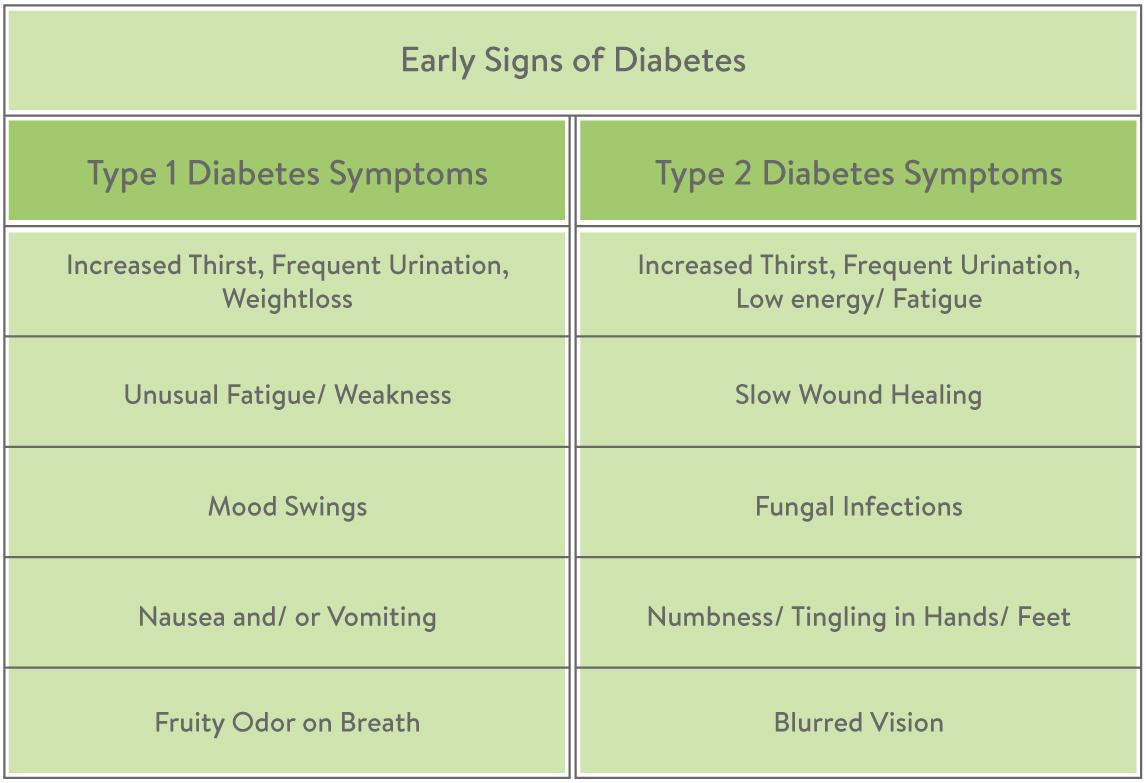
Since 2012, our goal at mySugr has always been to make diabetes suck less for people within the diabetic community. We have long endeavored to educate, advocate, and elevate the global working knowledge of living life with both Type 1 and Type 2 Diabetes to the fullest. Utilizing our combination approach of sound coaching and advancing tech, we’ve made huge strides at creating an environment that lets all people with diabetes maintain optimum health while living their best life!
Living with diabetes without knowing it
But we know awareness isn’t limited to just people already diagnosed. It is estimated that a staggering 20% of people reported as clinically diabetic have no prior knowledge of their diagnosis. That means there are millions of people walking around with dangerously elevated blood glucose levels that are undiagnosed and receiving no medical treatment for the growing signs of diabetes their body is showing. Thus, we wanted to stretch our reach outside the diabetic community and into the non-diabetic populace and ask one simple question:
Do you know the early symptoms of diabetes?
Click, Read, Share.
Help us spread awareness and education on the early symptoms of diabetes! If you have a family history of diabetes, you should ask your doctor for pre-screening and lab work to check for early diabetes signs.
Annual lab work, or a quick bi-annual finger stick, can offer you and your doctor a solid baseline to monitor for any premature rise in blood glucose levels.
If you or your child struggle to maintain a healthy weight, ask your doctor and/or your child’s pediatrician for pre-screening and lab work to look out for early signs of diabetes. By working hand in hand to achieve optimum health, you and your medical team can be proactive partners in warding off any symptoms of diabetes before they begin to damage peripheral systems.
If you or your child have other genetic factors (such as other auto-immune conditions), you should ask your doctor for pre-screening lab work to rule out any signs of diabetes. Auto-immune conditions tend to breed additional auto-immune conditions. Still, by creating a team-work approach to full-body care, you can provide a protective screening system that stands sentry against the early warning signs of diabetes. In this way, you can begin any treatment at the earliest possible opportunity and set the stage for successful long-term health.
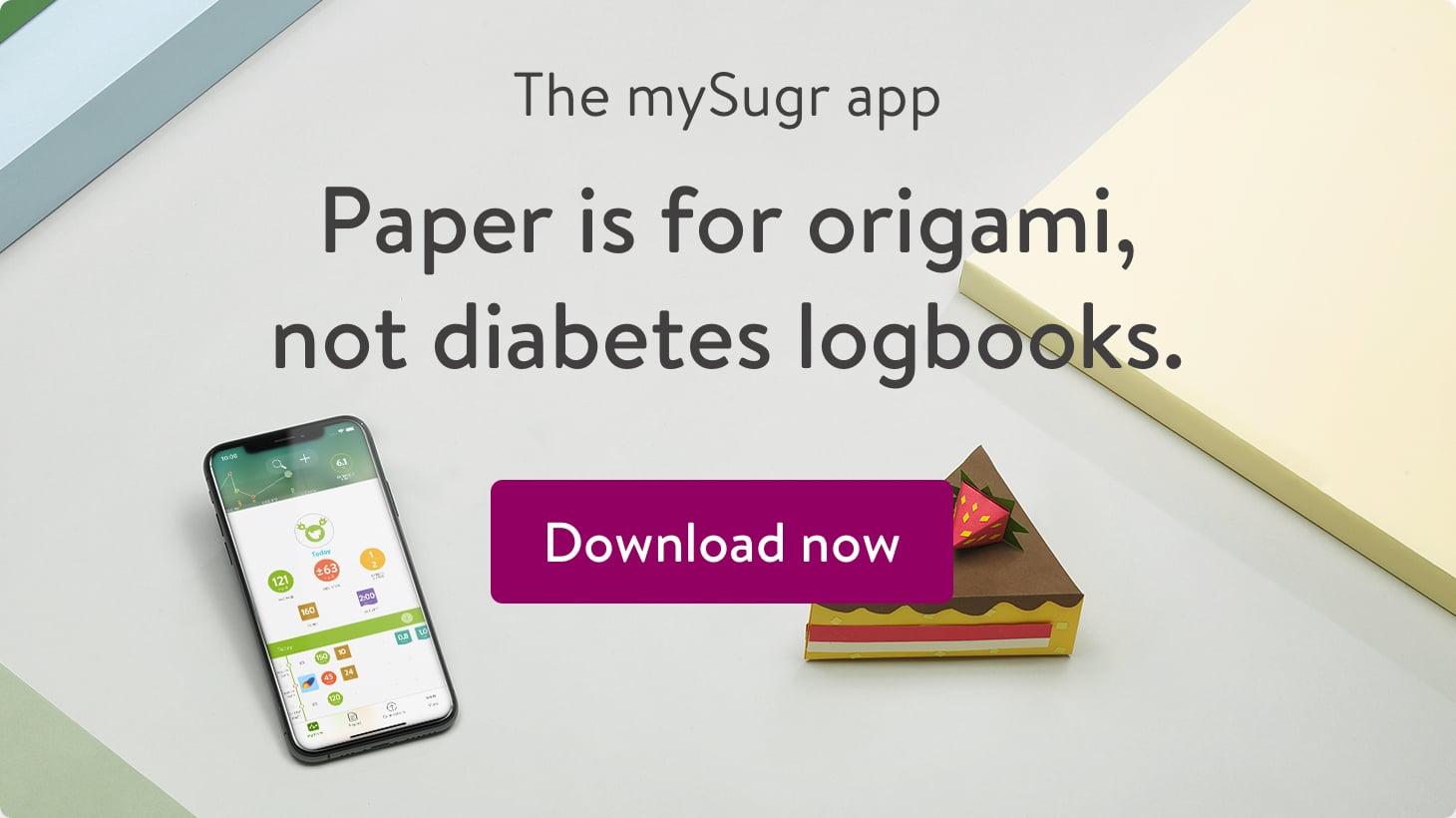
The mySugr website does not provide medical or legal advice. mySugr blog articles are not scientific articles, but intended for informational purposes only.
Medical or nutritional information on the mySugr website is not intended to replace professional medical advice, diagnosis or treatment. Always consult a physician or health care provider with any questions you may have regarding a medical condition.





